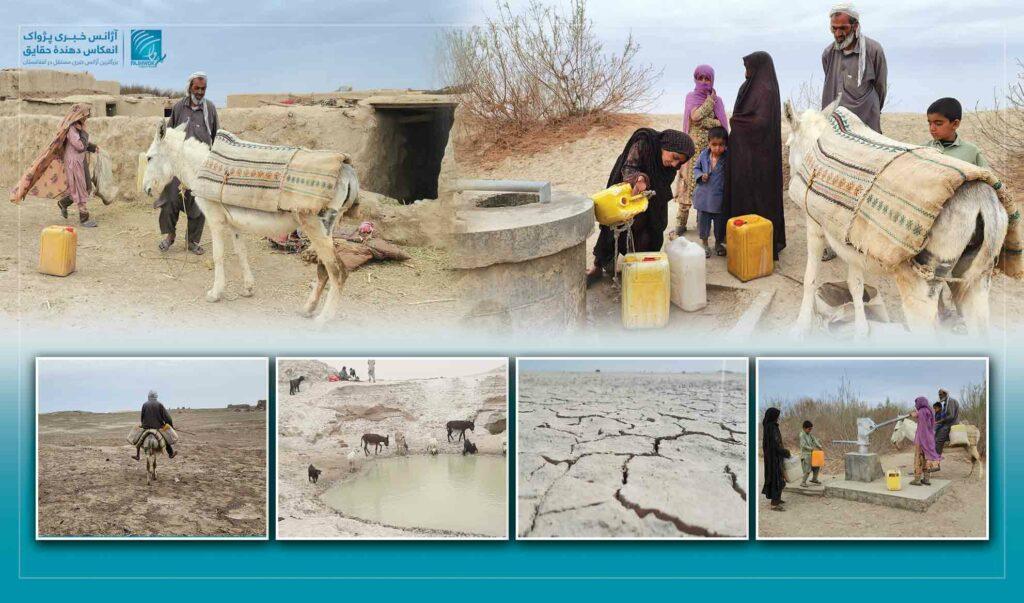
Drought In Nimroz Behind Exodus, Livestock Loss
ZARANJ (Pajhwok): Farmers and livestock owners in Zaranj, the capital of Nimroz province, and several districts have been severely affected by a two-year drought, with many residents migrating elsewhere in search of better living conditions.
Rahmatullah, also known as Haji Abdulrahman, a landowner and the head of Rahman village in the Chakhansur district, told Pajhwok Afghan News:“Last year, 1,500 acres of land was cultivated in our village, with hundreds of farmers working tirelessly from dawn to dusk. At the beginning of this year, water arrived once, allowing people to plant crops. But after that, we never saw water again.”
Now, as he prepares his land for cultivation, Rahmatullahlaments,“Last year, people planted crops, purchased seeds, and paid for tractor services, only for floods to come in winter and destroy everything. Now, there is not a single plant of wheat or barley in all of Chakhansur. The people have scattered.”
He sighs, saying,“Livestock owners have also moved. Many have taken their animals to Laash Joeen district in Farah, Herat, Helmand, or Zaranj. I myself moved my livestock to Helmand, while some have sold their animals.”
In Rahman village, where 112 families once lived, only 64 families remain due to drought and unemployment, leading to widespread displacement.
Naeem Baloch, a livestock owner from the district, shares his story:“I had 300 goats and sheep, but due to the drought, many perished, and others had to be moved to Laash Joeen district in Farah to survive. Now, I'm considering migrating to Iran due to unemployment.”
This crisis isn't limited to Chakhansur. Residents of Khanjdistrict also face similar challenges. Raheema, a 45-year-old woman from Mawlanaa village in Zaranj city, is forced to travel twice a day, once in the morning and once in the afternoon, to fetch two barrels of water, walking over thorn-filled fields to reach the well. Despite her disability, she and her two daughters carry the heavy barrels.
She explains,“The water in our village is mostly salty and undrinkable.”
Abdullah, 50, from Khoday Rahim village in Zaranj city, shares a similar experience. Riding a mule, he travels with a group of women and children to fetch water from a well in a neighboring village.“The wells in our village have dried up,” he says.“I can get there in an hour, but the women walk on foot for two hours. The water is salty, but we have no choice but to use it.”
In summer, water shortage becomes even more severe, as the well water decreases due to intense heat. More than 70 families in their village rely on this well.
The drought has also taken a heavy toll on Kang district. Gul Bibi, a resident of Darweshk village, says,“The entire village has fled due to the drought. There's no farming, no wheat, and no livestock. We are just struggling to find food for the evening.”
She adds,“In summer, we carry four buckets of water, but when the well dries up, we wait for two hours for it to return, taking turns to fetch it.”
Maulvi Mohammad Jumma Islamyar, the head of the Kang district council, expresses grave concern about the dire situation:“Kang, once a prosperous and green district with the highest population in Nimroz, has been devastated by the drought. People have been driven to despair, and the district is now deserted.”
While some families have dug their own wells, MaulviIslamyar reports that they lock their wells to prevent others from using them.
Maulvi Ahmad Sabet, deputy head of Kang district, says,“Due to the drought, 80 percen of livestock in Kang has been lost. Some livestock owners who could afford to migrate have moved to Badghis, Farah, and Helmand, while others who couldn't afford to migrate have sold their livestock.”
In the face of the water crisis, Sabet adds,“In Kang, people mix half a barrel of salty water with half a barrel of fresh water, if they can find any, to drink. This water isn't even fit for animals, let alone for humans.”
Previously, Kang had a population of 20,000, but due to the water shortage and drought, the population has dwindled to 10,000, with many villages now empty.
Maulvi Abdul Khaliq Hakimullah, head of agriculture and livestock in Nimroz, confirms a sharp decline in both livestock and agricultural production across the province. He reports that the province has about 85,886 hectares of agricultural land, but due to consecutive droughts and water shortages, the area under cultivation in the central and districts of Kang, Chakhansur, and Chahar Burjak has decreased significantly.
The primary reason for this decline, according to Hakimullah, is the ongoing drought and the lack of seasonal rainfall in the province.
Engineer Ibrahim Raisi, head of the Zaranj Sub-Division of the Water Resources Department, highlights the worsening water crisis. He explains that underground water levels in Nimroz are closely linked to surface water from the Helmand River.“When the surface water flow is interrupted for several months, underground water levels automatically decrease,” he says.“This year, the underground water level in Nimroz has dropped by two meters compared to last year.”
This water crisis is not only affecting Nimroz but also many other regions worldwide, with experts emphasizing the importance of not overusing underground water resources.
sa/ma

Legal Disclaimer:
MENAFN provides the information “as is” without warranty of any kind. We do not accept any responsibility or liability for the accuracy, content, images, videos, licenses, completeness, legality, or reliability of the information contained in this article. If you have any complaints or copyright issues related to this article, kindly contact the provider above.






















Comments
No comment